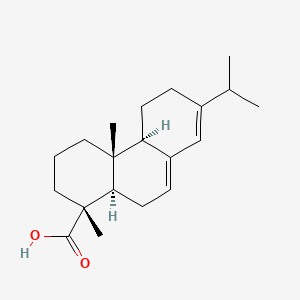| MeSH term | MeSH ID | Detail |
|---|---|---|
| Dermatitis, Contact | D003877 | 59 associated lipids |
| Edema | D004487 | 152 associated lipids |
| Occupational Diseases | D009784 | 42 associated lipids |
| Asthma | D001249 | 52 associated lipids |
| Weight Gain | D015430 | 101 associated lipids |
| Cell Transformation, Neoplastic | D002471 | 126 associated lipids |
| Ulcer | D014456 | 16 associated lipids |
| Psoriasis | D011565 | 47 associated lipids |
Abietic acid
Abietic acid is a lipid of Prenol Lipids (PR) class. Abietic acid is associated with abnormalities such as Hand eczema, Dermatitis, Vitelliform dystrophy, Wiskott-Aldrich Syndrome and Dehydration. The involved functions are known as Process, Oxidation, Anabolism, Transmembrane Transport and physiological aspects. Abietic acid often locates in Membrane, Protoplasm, Microsomes and Cellular Membrane. The associated genes with Abietic acid are SLC33A1 gene and ABCG2 gene. The related lipids are Pinene.
Cross Reference
Introduction
To understand associated biological information of Abietic acid, we collected biological information of abnormalities, associated pathways, cellular/molecular locations, biological functions, related genes/proteins, lipids and common seen animal/experimental models with organized paragraphs from literatures.
What diseases are associated with Abietic acid?
Abietic acid is suspected in Hand eczema, Dermatitis, Dehydration and other diseases in descending order of the highest number of associated sentences.
Related references are mostly published in these journals:
| Disease | Cross reference | Weighted score | Related literature |
|---|
Possible diseases from mapped MeSH terms on references
We collected disease MeSH terms mapped to the references associated with Abietic acid
PubChem Associated disorders and diseases
What pathways are associated with Abietic acid
There are no associated biomedical information in the current reference collection.
PubChem Biomolecular Interactions and Pathways
Link to PubChem Biomolecular Interactions and PathwaysWhat cellular locations are associated with Abietic acid?
Visualization in cellular structure
Associated locations are in red color. Not associated locations are in black.
Related references are published most in these journals:
| Location | Cross reference | Weighted score | Related literatures |
|---|
What functions are associated with Abietic acid?
Related references are published most in these journals:
| Function | Cross reference | Weighted score | Related literatures |
|---|
What lipids are associated with Abietic acid?
Related references are published most in these journals:
| Lipid concept | Cross reference | Weighted score | Related literatures |
|---|
What genes are associated with Abietic acid?
Related references are published most in these journals:
| Gene | Cross reference | Weighted score | Related literatures |
|---|
What common seen animal models are associated with Abietic acid?
There are no associated biomedical information in the current reference collection.
NCBI Entrez Crosslinks
All references with Abietic acid
Download all related citations| Authors | Title | Published | Journal | PubMed Link |
|---|---|---|---|---|
| Saito K et al. | An in vitro skin sensitization assay termed EpiSensA for broad sets of chemicals including lipophilic chemicals and pre/pro-haptens. | 2017 | Toxicol In Vitro | pmid:27965148 |
| Jagalski V et al. | Biophysical study of resin acid effects on phospholipid membrane structure and properties. | 2016 | Biochim. Biophys. Acta | pmid:27544924 |
| Costa MS et al. | The conifer biomarkers dehydroabietic and abietic acids are widespread in Cyanobacteria. | 2016 | Sci Rep | pmid:26996104 |
| Geisler K et al. | Modularity of Conifer Diterpene Resin Acid Biosynthesis: P450 Enzymes of Different CYP720B Clades Use Alternative Substrates and Converge on the Same Products. | 2016 | Plant Physiol. | pmid:26936895 |
| Sadashiva MP et al. | A non-cytotoxic N-dehydroabietylamine derivative with potent antimalarial activity. | 2015 | Exp. Parasitol. | pmid:25982031 |
| Rafferty RJ et al. | Synthesis of complex and diverse compounds through ring distortion of abietic acid. | 2014 | Angew. Chem. Int. Ed. Engl. | pmid:24273016 |
| Kazakova OB et al. | [Synthesis, structure and farmacologycal activity of (7R,8S)-epoxy-(13R,17R)-trioxolaneabietic acid]. | 2013 Mar-Apr | Bioorg. Khim. | pmid:23964524 |
| Janocha S and Bernhardt R | Design and characterization of an efficient CYP105A1-based whole-cell biocatalyst for the conversion of resin acid diterpenoids in permeabilized Escherichia coli. | 2013 | Appl. Microbiol. Biotechnol. | pmid:23793341 |
| Slade JH and Knopf DA | Heterogeneous OH oxidation of biomass burning organic aerosol surrogate compounds: assessment of volatilisation products and the role of OH concentration on the reactive uptake kinetics. | 2013 | Phys Chem Chem Phys | pmid:23487256 |
| Shpatov AV et al. | Lipophilic extracts from needles and defoliated twigs of Pinus pumila from two different populations. | 2013 | Chem. Biodivers. | pmid:23418167 |
